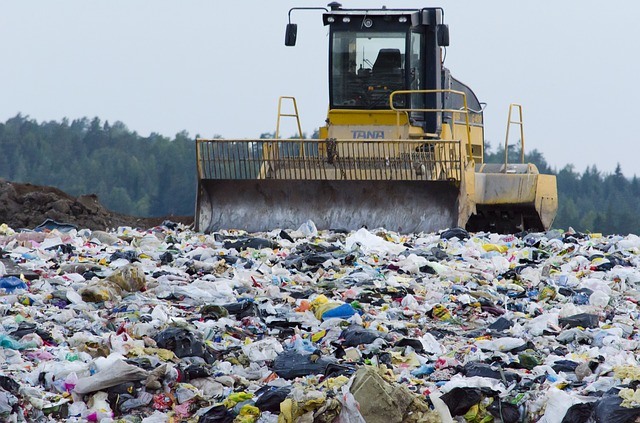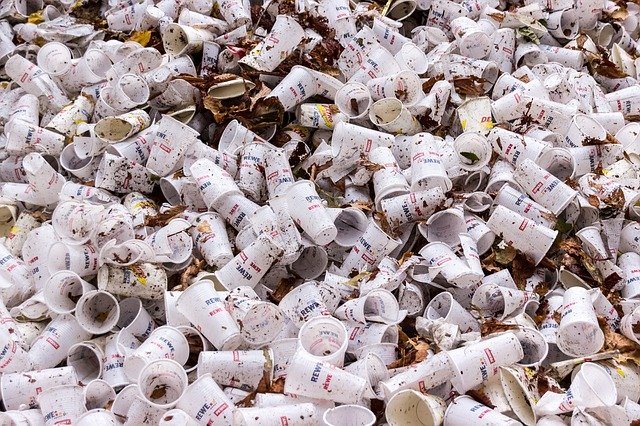An interesting possibility to get rid of our plastic waste
We have all heard of the growing problem of plastic wastes. Plastic can, over time, breakdown in the presence of ultraviolet light (UV). UV will degrade plastics. However, the product of the degradation will probably still be a toxic chemical.
Ultimately, plastics will completely degrade, but because plastics are a relatively new product, no one knows exactly how long it will take for a single plastic article to degrade to simple molecules. Some estimates are in the range of 500 to 1,000 years.

Landfill with heaps of plastic image by Pasi Maeupaa
An additional problem with this scenario is that the plastic needs to be in the presence of UV. If it is in a landfill, it will not degrade. That was the case but recently, microbes have been identified as a potential source for “biodegradation” of plastics.
Biodegradation differs from degradation in that unlike simple degradation which breaks pieces up into smaller and smaller pieces of the same material, biodegradation will convert the plastic into simple molecules bypassing the breaking into smaller particles phase.
In 2008, a young man in Canada identified that microbes can speed up biodegradation, converting the equivalent of a plastic bag into simple molecules within 3 months. But as the young man said, this would be best on an industrial scale because fermenting tanks would be necessary. But what about the plastics already in a landfill?

Wax-worm image by Skeeze
A Natural Solution, the Waxworm
Environmental Science and Technology published an article in 2014 that described the biodegradation of Polyethylene (PE) by bacterial strains from the guts of Waxworms. The study reported that between 6.1 and 10.7% of a PE test film had degraded within 60 days.
In a 2015 report, a team identified mealworms that can consume polystyrene as a food source and not be harmed by the consumption. Roughly half of the polystyrene consumed was discharged as waste, but the rest was converted to carbon dioxide through respiration.
Additional work showed that the gut bacteria of the mealworms were the major heroes of this process. But just adding the bacteria to the plastic will not produce the same results, possibly due to the need for a controlled (warm and wet) environment evident in the mealworm’s gut.
Do not miss the interesting video.
The Use of Enzymes
In 2016, a team from Kyoto University has identified that enzymes can be used to break down poly(ethylene terephthalate) (PET), a common form of plastics used in bottles and clothing. These enzymes might be introduced to a plastic-filled landfill and allowed to work their magic.
But the product from this enzyme breakdown is Ethylene-glycol and terephthalic acid. I am uncertain of the ultimate results of this enzyme action.
Recently, National Geographic published an article detailing a discovery that a different species of waxworms work much in the same way that was reported in the 2014 study mentioned above. The article details the accidental discovery that a beekeeper had stumbled upon.
It just happened that the beekeeper was also a developmental biologist. She found waxworms in her beehives and removed them, placing them in a plastic bag for disposal later. An hour later, she found the bag was empty and had holes in it.
She guessed what had happened. Since they eat wax (a large chain polymer molecule), it was possible that they had developed a way to eat the long-chain polymer of the plastic. She started working on the concept and experimented a little.
Her team identified in a controlled study, that the waxworms consumed 92 milligrams of a plastic shopping bag overnight. At this rate, 100 worms would consume a 5.5-gram plastic bag in a month.
A special book
In this interesting book by Yvonne Shashoua, you will hear about the historical development of plastics. The technology and physical and chemical properties. This is an important work for conservators and curators as they encounter plastics in their day-to-day work.
Nowadays you will find plastic works of art in museums and galleries, but one needs special knowledge to preserve them from deteriorating after only being a few years old.
Plastic Waste is a Global Problem
It is recognized that plastic wastes are a global problem and only growing. The idea of adding worms or enzymes to a landfill to consume the plastic sounds well and good. However, keep in mind that any time humans try to meddle with nature, unseen problems pop up.
Adding waxworms or any other worm to a food source will cause an explosion in the population. And the worms eventually pupate and become a different kind of pest. If you add an enzyme to a landfill, will it migrate or stay in place?
Finally, we are aware of the production of Biodegradable Plastics (BDPs). BDPs can be manufactured from strictly plant-based (bio-based) as well as petrochemical-based or a mix of the two. This increases the confusion of how to treat the wastes and what the resulting products might be. Bioplastics may not be as ideal as one might think.

Plastic-cups image by Meineresterampe
Conclusion
Reports suggest that bioplastic polymers are much higher in cost than traditional plastic products, with bio-plastics being generally being 2 to 4 times as expensive to produce. Ultimately, we need to initially focus on reduction and recycling. Reduction, when possible, is preferred.
Take cloth bags to the grocery when buying your goods and encourage your compatriots to do the same. When you cannot avoid using plastic, recycle it. These options are much more cost-effective than all the choices listed above.
It is of course very interesting there are worms that eat plastic. But, it seems we do not realize how serious plastic pollution is for the environment and also for our health. Did you know that we even have microscopic pieces of plastic in our food?
Scientists have concluded that modern man eats the equivalent of the plastic of a credit card every week. That is a staggering 2000 pieces. Don’t you think that is crazy?
I have made a collection of things you might find interesting. Before you leave, have a look at Recommendations.
Source: Wikipedia
Photo Source: Pixabay
We are being smothered by plastic in our world. Most things are made of plastic. You might care to also read the following post.









Comments
Michelle
Hello Taetske,
Very interesting article. Extremely informative. I did not know about the waxworm. It is good to know that somehow there is a way to break down the plastic usage in our environment. Of course, we all need to do our small part to make this happen on a big scale.
I enjoy recycling and I love Mother Earth. I try my bestnot to use plastic, however, when I do, I recycle. Thanks for sharing.
Michelle
admin
Good afternoon Michelle,
Thank you for your comment. Indeed we can all put our grain of sand. If we really all would do that it would mean a positive change.I am very unhappy what has just happened in the US. That sadly is a gigantic step backward. I will keep posting things relative to this and I hope you will visit again.
Regards, Taetske
writeessay
write an essay for me http://dekrtyuijg.com/
Wow a good deal of beneficial material.
Taetske
Good afternoon,
Thank you for leaving a, I must say, short comment on my post.
What a shame you did not leave your name. I like to communicate with my readers by name, more personal you know.
So please, try again and then we will continue talking.
Regards, Taetske
Kehinde Segun
Thank you,Taetske.
This lovely, wonderful and highly informative article. Readers are truly leaders. thanks to wonderful, intellectual writers like you.
I never knew there is a good way to manager plastic usage in our environment. such a good way.
I’m glad i stumble to good informative article like this. I think I’m gonna start making recycling of plastic my hobby now. If not for anything, but to save my environment
Thumbs up to you, Taetske
Taetske
Good Morning Kehinde,
Nice to hear you found this article informative. That the waxworm can be a help in the battle against plastic pollution is great but it is not enough. The total amount of plastic pollution in the world is so enormous that more things need to be done.
We should all help on a personal level. Start with separating our own waste so it can be recycled. Good to hear that reading my post has inspired you to take action.
Thank you for your comment. I hope you downloaded your free PDF?
Regards, Taetske
Shellykh
Oh wow, it’s so great to have a peace in mind that there is something that can degrade plastic. Never thought it would be mealworms or waxworms would be the ones who could save our planet. I just hope the government will catch on soon on this research as it could save $billions in the future.
Taetske
Good Morning Shellykh,
Thank you for leaving a comment on my website. I hope you have downloaded your free PDF?
Even if the waxworm is a good solution to get rid of our plastic waste it will not be able to cope with the total. Many more things are needed to get rid of plastic pollution. We all have to help with this.
Regards, Taetske
zuchii
The world is getting ready in earnest for a time without plastic plans and actions as well as deadlines have all been put in place, unlike the issue of climate change where there are varying opinion as regards its authenticity and motives we all agree that plastic has damaged our environment for way too long, its harm on the environment outweighs it’s benefit especially when there are lots of other options.
Taetske
Good Morning Zuchii,
Thank you for your visit and leaving a comment. Nice to see you again.
Slowly but surely people become conscious of the threat plastic poses to our environment. Many good plans are put into action to clean up but it is far from being enough.
Global Warming = Climate Change is really needing serious attention. There is proof all over the world it is happening. It is affecting all of us believe it or not.
Regards, Taetske
Terri
Hello Taetske!
Your article opened my eyes more, yet sad because of the increase of plastics being disposed everywhere here on earth. I never knew of the waxworms and that is very interesting to learn. Just imagining the number of years for plastics to degrade is heartbreaking.
This is such an IMPORTANT topic for everyone that are not practicing proper recycling of materials. Fortunately, I moved from California where recycling is almost mandatory. We have 3 different receptacles or cans for weekly pickup: Trash, Recyclables and Compostables. I recall someone told me that they were fined for not recycling properly.
Though it’s not a requirement here where we live now, I still do that extra step by separating them. Also, in California, you have to bring your own shopping bag (cloth or what have you), or you pay ten cents for a paper bag. Grocery stores no longer provide plastic bags.
Even with those 3 separate receptacles, I still see residents not doing their responsibility to Mother Earth. So, thank you so much for sharing this blog.
Terri
Taetske
Good Morning Terri,
Thank you for your comment. I hope you downloaded your free PDF?
Yes, this waxworm is quite a little creature but he cannot manage all the plastic waste. We have a responsibility and have to do our bit.
Here in Spain where I live, we put all the organic waste into the vegetable garden. Very good for the soil. Then we separate plastic, glass, paper, and carton, and then the normal waste. It does help. When we go shopping we also only take our own bags and try to avoid buying things which are wrapped in plastic.
Mother Earth is suffering because we do many harmful and stupid things.
Regards, Taetske
TERRI
I’m not sure which PDF. Did I miss reading it? Also, for some reason, I didn’t get a notification that you’ve replied to my comment.
Taetske
Good Morning Terri,
When it is a comment from WA people you have to go yourself and look on Site Comments. If the comment comes from outside I have the plugin installed to notify the visitor his/her comment has been approved. As you now have made a direct comment you should be notified about it.
When you go to the sidebar, under my photo, you see a widget with tulips. There you click and will see a company who gives out free PDFs, you can choose what you want. I think it is a super source.
Regards, Taetske
arnaiemhasan
Hi ,
This is the most important article in our environment about our plastic waste . If you look around you , plastic is everywhere . Some of this plastic is denoted to be used over and over again for a long time . However ,is used for only a very short amount of time .So, It is probably impossible to totally eliminate plastic from our lives but there are important steps we can take to reduce the amount of plastic we use .
Thanks .
Taetske
Good Morning Arnaiem,
Thank you for visiting my website and leaving a comment. I hope you have downloaded your free PDF?
We can do a lot on a personal level. Take your own cloth bags when you go shopping. Do not buy vegetables and fruits wrapped up in plastic, Having a drink in the bar do not use plastic straws. Each household should separate the waste into carton, glass, plastic, normal waste, and organic waste. that also helps
Regards, Taetske.
Anthony Hu
Thank you for your post. Plastic waste is going to be one of the biggest pollution to our planet. It is nice to see that there is solution to resolve this issue using bio-degradation of plastic.
The natural solution, the waxworm, is truly a smart solution to degrade the plastic. With the rapid advancement of science and technology in the field, I am confident that we are going to have powerful bacteria to digest the plastic.
I agree with you that we need to take active measures right now to control the generation of plastic wastes. User alternative tool, such as cloth bags as you mentioned, and recycle them if you use plastic tools.
Taetske
Good Morning Anthony,
Thank you for your visit and for your comment on my website. I hope you downloaded your free PDF? Tulip widget.
Plastic waste is one of the biggest problems in our world. I have seen very sad photographs where rivers were so full of floating garbage that one could not see the water anymore. The same applies to the oceans where animals are being killed by plastic.
These natural solutions to get rid of plastic are needed and I hope that in the future more systems are invented to liberate the environment from this plastic plaque.
Regards, Taetske